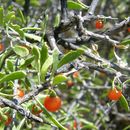pt-BR
nomes no trilho de navegação


Lycium berlandieri ist eine Pflanzenart aus der Gattung der Bocksdorne (Lycium) in der Familie der Nachtschattengewächse (Solanaceae).
Lycium berlandieri ist ein 0,7 bis 2,5 m hoher, spärlich verzweigter Strauch. Seine Laubblätter sind unbehaart, 1 bis 2,5 mm lang und 1,5 bis 6 mm breit.
Die Blüten sind zwittrig und vier- oder fünfzählig. Der Kelch ist becherförmig, die Kelchröhre ist 1 bis 3 mm lang, die Länge der Kelchzipfel entspricht etwa 1/3 der Länge der Kelchröhre. Die Spitzen der Kelchzipfel sind mit einem kleinen Haarbüschel besetzt. Die Krone ist weiß oder blass lavendelfarben gefärbt und verkehrt kegelförmig-trichterförmig. Die Länge der Kronröhre ist 4 bis 9 mm, die Länge der Kronlappen entspricht 1/6 bis 1/3 der Länge der Kronröhre. Die Staubfäden sind im untern Drittel des freistehenden Teils dicht behaart.
Die Frucht ist eine kugelförmige Beere mit einem Durchmesser von 5 mm. Sie enthält eine Vielzahl von Samen.
Die Chromosomenzahl beträgt 2n = 36.[1]
Die Art ist in Nordamerika verbreitet und kommt dort in den Mexikanischen Bundesstaaten Baja California Sur, Sonora, Sinaloa, Chihuahua, Durango, Coahuila, Tamaulipas, Hidalgo, Nuevo León und San Luis Potosí, sowie in den US-amerikanischen Bundesstaaten Arizona, New Mexico und Texas vor.[2]
Innerhalb der Art werden vier Varietäten unterschieden:
Innerhalb der Bocksdorne (Lycium) wird die Art nach phylogenetischen Untersuchungen in eine Klade mit anderen nord- und südamerikanischen Arten der Gattung gruppiert. Die Art ist nahe verwandt mit Lycium americanum, Lycium infaustum, Lycium exsertum, Lycium fremontii, Lycium parishii, Lycium texanum, Lycium torreyi, Lycium andersonii, Lycium elongatum, Lycium athium und Lycium minimum.
Lycium berlandieri ist eine Pflanzenart aus der Gattung der Bocksdorne (Lycium) in der Familie der Nachtschattengewächse (Solanaceae).
Lycium berlandieri is a species of flowering plant in the nightshade family known by the common name Berlandier's wolfberry. It is native to Mexico and the south-western United States from Arizona to Texas.[1]
This shrub reaches up to 2 metres (6 ft 7 in) tall. The roots may extend 9 metres (30 ft) from the plant. It has spiny branches. It loses its leaves and becomes dormant during dry times. The bell-shaped flowers are solitary or borne in pairs. The fruit is a juicy red berry. This plant's life span is 90 years on average.[1]
This plant is characteristic of the flora of the Sonoran and Chihuahuan Deserts. It is rarely dominant, but it occurs in many types of desert habitat, including mesquite and saltbush plant communities, creosote, grassland, prairie, and savanna. It can grow in desert salt flats and other saline habitats. It may invade grassland along with mesquite during the process of ecological succession. In the Sonoran and Chihuahuan Deserts it grows alongside ocotillo (Fouquieria splendens), saguaro (Carnegiea gigantea), range ratany (Krameria parvifolia), ironwood (Olneya tesota), jojoba (Simmondsia chinensis), false-mesquite (Calliandra eriophylla), brittlebush (Encelia farinosa), leatherstem (Jatropha cardiophylla), feather dalea (Dalea formosa), yucca, agave, Opuntia cacti, and acacia species. In Texas it can be found in sandy arroyos and more saline areas alongside mesquite and hackberry.[1]
Many birds and rodents consume the fruits of the shrub. Gambel's quail live in habitat where the shrub is common, and they use it for cover and nesting.[1]
Native Americans consumed the fruits and used the plant medicinally.[1]
Lycium berlandieri is a species of flowering plant in the nightshade family known by the common name Berlandier's wolfberry. It is native to Mexico and the south-western United States from Arizona to Texas.
This shrub reaches up to 2 metres (6 ft 7 in) tall. The roots may extend 9 metres (30 ft) from the plant. It has spiny branches. It loses its leaves and becomes dormant during dry times. The bell-shaped flowers are solitary or borne in pairs. The fruit is a juicy red berry. This plant's life span is 90 years on average.
This plant is characteristic of the flora of the Sonoran and Chihuahuan Deserts. It is rarely dominant, but it occurs in many types of desert habitat, including mesquite and saltbush plant communities, creosote, grassland, prairie, and savanna. It can grow in desert salt flats and other saline habitats. It may invade grassland along with mesquite during the process of ecological succession. In the Sonoran and Chihuahuan Deserts it grows alongside ocotillo (Fouquieria splendens), saguaro (Carnegiea gigantea), range ratany (Krameria parvifolia), ironwood (Olneya tesota), jojoba (Simmondsia chinensis), false-mesquite (Calliandra eriophylla), brittlebush (Encelia farinosa), leatherstem (Jatropha cardiophylla), feather dalea (Dalea formosa), yucca, agave, Opuntia cacti, and acacia species. In Texas it can be found in sandy arroyos and more saline areas alongside mesquite and hackberry.
Many birds and rodents consume the fruits of the shrub. Gambel's quail live in habitat where the shrub is common, and they use it for cover and nesting.
Native Americans consumed the fruits and used the plant medicinally.
Lycium berlandieri là loài thực vật có hoa trong họ Cà. Loài này được Dunal mô tả khoa học đầu tiên năm 1852.[1]
Lycium berlandieri là loài thực vật có hoa trong họ Cà. Loài này được Dunal mô tả khoa học đầu tiên năm 1852.